An Ensemble-Based Machine Learning Model for Estimation of Subsurface Thermal Structure in the South China Sea
Abstract
1. Introduction
2. Data and Methods
2.1. Data
2.2. Methods
3. Results
4. Discussion and Conclusions
Author Contributions
Funding
Data Availability Statement
Acknowledgments
Conflicts of Interest
References
- Levitus, S.; Antonov, J.I.; Boyer, T.P.; Baranova, O.K.; Garcia, H.E.; Locarnini, R.A.; Mishonov, A.V.; Reagan, J.R.; Seidov, D.; Yarosh, E.S.; et al. World ocean heat content and thermosteric sea level change (0–2000 m), 1955–2010. Geophys. Res. Lett. 2012, 39, L10603. [Google Scholar] [CrossRef]
- Abraham, J.P.; Baringer, M.; Bindoff, N.; Boyer, T.; Cheng, L.; Church, J.A.; Conroy, J.L.; Domingues, C.M.; Fasullo, J.; Gilson, J.; et al. A review of global ocean temperature observations: Implications for ocean heat content estimates and climate change. Rev. Geophys. 2013, 51, 450–483. [Google Scholar] [CrossRef]
- Pearce, A.F.; Feng, M. The rise and fall of the “marine heat wave” off Western Australia during the summer of 2010/2011. J. Mar. Syst. 2013, 111–112, 139–156. [Google Scholar] [CrossRef]
- Oliver, E.C.J.; Donat, M.G.; Burrows, M.T.; Moore, P.J.; Smale, D.A.; Alexander, L.V.; Benthuysen, J.A.; Feng, M.; Gupta, A.S.; Hobday, A.J.; et al. Longer and more frequent marine heatwaves over the past century. Nat. Commun. 2018, 9, 1324. [Google Scholar] [CrossRef]
- Du, Y.; Zhang, Y.; Zhang, L.; Tozuka, T.; Ng, B.; Cai, W. Thermocline Warming Induced Extreme Indian Ocean Dipole in 2019. Geophys. Res. Lett. 2020, 47, e2020GL090079. [Google Scholar] [CrossRef]
- Wallace, J.M.; Rasmusson, E.M.; Mitchell, T.P.; Kousky, V.E.; Sarachik, E.S.; von Storch, H. On the structure and evolution of ENSO-related climate variability in the tropical Pacific: Lessons from TOGA. J. Geophys. Res. Earth Surf. 1998, 103, 14241–14259. [Google Scholar] [CrossRef]
- Planton, Y.Y.; Vialard, J.; Guilyardi, E.; Lengaigne, M.; McPhaden, M.J. The asymmetric influence of ocean heat content on ENSO predictability in the CNRM-CM5 coupled general circulation model. J. Clim. 2021, 34, 5775–5793. [Google Scholar] [CrossRef]
- Sprintall, J.; Tomczak, M. On the formation of central water and thermocline ventilation in the southern hemisphere. Deep Sea Res. Part I: Oceanogr. Res. Pap. 1993, 40, 827–848. [Google Scholar] [CrossRef]
- Qi, J.; Qu, T.; Yin, B.; Chi, J. Variability of the South Pacific Western Subtropical Mode Water and Its Relationship with ENSO During the Argo Period. J. Geophys. Res. Oceans 2020, 125, e2020JC016134. [Google Scholar] [CrossRef]
- Qu, T. Upper-layer circulation in the South China Sea. J. Phys. Oceanogr. 2000, 30, 1450–1460. [Google Scholar] [CrossRef]
- Qu, T.; Kim, Y.Y.; Yaremchuk, M.; Tozuka, T.; Ishida, A.; Yamagata, T. Can Luzon Strait transport play a role in conveying the impact of ENSO to the South China Sea? J. Clim. 2004, 17, 3644–3657. [Google Scholar] [CrossRef]
- Wang, G.; Xie, S.-P.; Qu, T.; Huang, R.X. Deep South China Sea circulation. Geophys. Res. Lett. 2011, 38, L05601. [Google Scholar] [CrossRef]
- Qi, J.; Du, Y.; Chi, J.; Yi, D.L.; Li, D.; Yin, B. Impacts of El Niño on the South China Sea surface salinity as seen from satellites. Environ. Res. Lett. 2022, 17, 054040. [Google Scholar] [CrossRef]
- Qu, T. Role of ocean dynamics in determining the mean seasonal cycle of the South China Sea surface temperature. J. Geophys. Res. Earth Surf. 2001, 106, 6943–6955. [Google Scholar] [CrossRef]
- Wang, A.; Du, Y.; Peng, S.; Liu, K.; Huang, R.X. Deep water characteristics and circulation in the South China Sea. Deep Sea Res. Part I Oceanogr. Res. Pap. 2018, 134, 55–63. [Google Scholar] [CrossRef]
- Qu, T.; Song, Y.T.; Yamagata, T. An introduction to the South China Sea throughflow: Its dynamics, variability, and application for climate. Dyn. Atmos. Oceans 2009, 47, 3–14. [Google Scholar] [CrossRef]
- Wang, D.; Wang, Q.; Cai, S.; Shang, X.; Peng, S.; Shu, Y.; Xiao, J.; Xie, X.; Zhang, Z.; Liu, Z.; et al. Advances in research of the mid-deep South China Sea circulation. Sci. China Earth Sci. 2019, 62, 1992–2004. [Google Scholar] [CrossRef]
- Yao, Y.; Wang, C. Variations in Summer Marine Heatwaves in the South China Sea. J. Geophys. Res. Oceans 2021, 126, e2021JC017792. [Google Scholar] [CrossRef]
- Chen, J.-M.; Li, T.; Shih, C.-F. Fall Persistence Barrier of Sea Surface Temperature in the South China Sea Associated with ENSO. J. Clim. 2007, 20, 158–172. [Google Scholar] [CrossRef]
- Wu, C.-R.; Shaw, P.-T.; Chao, S.-Y. Assimilating altimetric data into a South China Sea model. J. Geophys. Res. Earth Surf. 1999, 104, 29987–30005. [Google Scholar] [CrossRef]
- Xie, J.; Counillon, F.; Zhu, J.; Bertino, L. An eddy resolving tidal-driven model of the South China Sea assimilating along-track SLA data using the EnOI. Ocean Sci. 2011, 7, 609–627. [Google Scholar] [CrossRef]
- Cornillon, P.; Stramma, L.; Price, J.F. Satellite measurements of sea surface cooling during hurricane Gloria. Nature 1987, 326, 373–375. [Google Scholar] [CrossRef]
- Carnes, M.R.; Teague, W.J.; Mitchell, J.L. Inference of Subsurface Thermohaline Structure from Fields Measurable by Satellite. J. Atmos. Ocean. Technol. 1994, 11, 551–566. [Google Scholar] [CrossRef]
- Ali, M.M.; Swain, D.; Weller, R.A. Estimation of ocean subsurface thermal structure from surface parameters: A neural network approach. Geophys. Res. Lett. 2004, 31, L20308. [Google Scholar] [CrossRef]
- Buckingham, C.E.; Cornillon, P.C.; Schloesser, F.; Obenour, K.M. Global observations of quasi-zonal bands in microwave sea surface temperature. J. Geophys. Res. Oceans 2014, 119, 4840–4866. [Google Scholar] [CrossRef][Green Version]
- Su, H.; Li, W.; Yan, X.-H. Retrieving Temperature Anomaly in the Global Subsurface and Deeper Ocean from Satellite Observations. J. Geophys. Res. Oceans 2018, 123, 399–410. [Google Scholar] [CrossRef]
- Mollo-Christensen, E.; Cornillon, P.; Mascarenhas, A.D.S. Method for Estimation of Ocean Current Velocity from Satellite Images. Science 1981, 212, 661–662. [Google Scholar] [CrossRef] [PubMed]
- Chu, P.C.; Fan, C.; Liu, W.T. Determination of Vertical Thermal Structure from Sea Surface Temperature. J. Atmospheric Ocean. Technol. 2000, 17, 971–979. [Google Scholar] [CrossRef]
- Cornillon, P.; Park, K.-A. Warm core ring velocities inferred from NSCAT. Geophys. Res. Lett. 2001, 28, 575–578. [Google Scholar] [CrossRef]
- Osychny, V.; Cornillon, P. Properties of Rossby Waves in the North Atlantic Estimated from Satellite Data. J. Phys. Oceanogr. 2004, 34, 61–76. [Google Scholar] [CrossRef][Green Version]
- Cheng, H.; Sun, L.; Li, J. Neural Network Approach to Retrieving Ocean Subsurface Temperatures from Surface Parameters Observed by Satellites. Water 2021, 13, 388. [Google Scholar] [CrossRef]
- Willis, J.K.; Roemmich, D.; Cornuelle, B. Combining altimetric height with broadscale profile data to estimate steric height, heat storage, subsurface temperature, and sea-surface temperature variability. J. Geophys. Res. Earth Surf. 2003, 108, 3292. [Google Scholar] [CrossRef]
- Guinehut, S.; Dhomps, A.-L.; Larnicol, G.; Le Traon, P.-Y. High resolution 3-D temperature and salinity fields derived from in situ and satellite observations. Ocean Sci. 2012, 8, 845–857. [Google Scholar] [CrossRef]
- Meijers, A.J.S.; Bindoff, N.; Rintoul, S. Estimating the Four-Dimensional Structure of the Southern Ocean Using Satellite Altimetry. J. Atmospheric Ocean. Technol. 2011, 28, 548–568. [Google Scholar] [CrossRef]
- Wu, X.; Yan, X.-H.; Jo, Y.-H.; Liu, W.T. Estimation of Subsurface Temperature Anomaly in the North Atlantic Using a Self-Organizing Map Neural Network. J. Atmospheric Ocean. Technol. 2012, 29, 1675–1688. [Google Scholar] [CrossRef]
- Charantonis, A.; Badran, F.; Thiria, S. Retrieving the evolution of vertical profiles of Chlorophyll-a from satellite observations using Hidden Markov Models and Self-Organizing Topological Maps. Remote Sens. Environ. 2015, 163, 229–239. [Google Scholar] [CrossRef]
- Khedouri, E.; Szczechowski, C.; Cheney, R. Potential Oceanographic Applications of Satellite Altimetry for Inferring Subsurface Thermal Structure. In Proceedings of the OCEANS’83, San Francisco, CA, USA, 29 August–1 September 1983; pp. 274–280. [Google Scholar] [CrossRef]
- DeWitt, P. Model decomposition of the monthly Gulf steam/Kuroshio temperature fields. NOO Tech. Rep. 1987, 298. [Google Scholar]
- Watts, D.R.; Sun, C.; Rintoul, S. A two-dimensional gravest empirical mode determined from hydrographic observations in the Subantarctic Front. J. Phys. Oceanogr. 2001, 31, 2186–2209. [Google Scholar] [CrossRef]
- Su, H.; Huang, L.; Li, W.; Yang, X.; Yan, X. Retrieving Ocean Subsurface Temperature Using a Satellite-Based Geographically Weighted Regression Model. J. Geophys. Res. Oceans 2018, 123, 5180–5193. [Google Scholar] [CrossRef]
- Yu, F.; Zhang, X.; Chen, X.; Chen, G. Altimetry-derived ocean thermal structure reconstruction for the Bay of Bengal cyclone season. Ocean Dyn. 2020, 70, 1449–1459. [Google Scholar] [CrossRef]
- Prochaska, J.; Cornillon, P.; Reiman, D. Deep Learning of Sea Surface Temperature Patterns to Identify Ocean Extremes. Remote Sens. 2021, 13, 744. [Google Scholar] [CrossRef]
- Chen, C.; Yang, K.; Ma, Y.; Wang, Y. Reconstructing the Subsurface Temperature Field by Using Sea Surface Data Through Self-Organizing Map Method. IEEE Geosci. Remote Sens. Lett. 2018, 15, 1812–1816. [Google Scholar] [CrossRef]
- Su, H.; Wu, X.; Yan, X.-H.; Kidwell, A. Estimation of subsurface temperature anomaly in the Indian Ocean during recent global surface warming hiatus from satellite measurements: A support vector machine approach. Remote Sens. Environ. 2015, 160, 63–71. [Google Scholar] [CrossRef]
- Li, W.E.; Su, H.; Wang, X.; Yan, X. Estimation of global subsurface temperature anomaly based on multisource satellite obser-vations. J. Remote. Sens. 2017, 21, 881–891. [Google Scholar]
- Su, H.; Yang, X.; Lu, W.; Yan, X.-H. Estimating Subsurface Thermohaline Structure of the Global Ocean Using Surface Remote Sensing Observations. Remote Sens. 2019, 11, 1598. [Google Scholar] [CrossRef]
- Su, H.; Wang, A.; Zhang, T.; Qin, T.; Du, X.; Yan, X.-H. Super-resolution of subsurface temperature field from remote sensing observations based on machine learning. Int. J. Appl. Earth Obs. Geoinf. 2021, 102, 102440. [Google Scholar] [CrossRef]
- Han, M.; Feng, Y.; Zhao, X.; Sun, C.; Hong, F.; Liu, C. A Convolutional Neural Network Using Surface Data to Predict Subsurface Temperatures in the Pacific Ocean. IEEE Access 2019, 7, 172816–172829. [Google Scholar] [CrossRef]
- Lu, W.; Su, H.; Yang, X.; Yan, X.-H. Subsurface temperature estimation from remote sensing data using a clustering-neural network method. Remote Sens. Environ. 2019, 229, 213–222. [Google Scholar] [CrossRef]
- Nardelli, B.B. A Deep Learning Network to Retrieve Ocean Hydrographic Profiles from Combined Satellite and In Situ Measurements. Remote Sens. 2020, 12, 3151. [Google Scholar] [CrossRef]
- Meng, L.; Yan, C.; Zhuang, W.; Zhang, W.; Geng, X.; Yan, X.-H. Reconstructing High-Resolution Ocean Subsurface and Interior Temperature and Salinity Anomalies from Satellite Observations. IEEE Trans. Geosci. Remote Sens. 2021, 60, 1–14. [Google Scholar] [CrossRef]
- Xiao, C.; Chen, N.; Hu, C.; Wang, K.; Gong, J.; Chen, Z. Short and mid-term sea surface temperature prediction using time-series satellite data and LSTM-AdaBoost combination approach. Remote Sens. Environ. 2019, 233, 111358. [Google Scholar] [CrossRef]
- Wolff, S.; O’Donncha, F.; Chen, B. Statistical and machine learning ensemble modelling to forecast sea surface temperature. J. Mar. Syst. 2020, 208, 103347. [Google Scholar] [CrossRef]
- Gracia, S.; Olivito, J.; Resano, J.; Martin-Del-Brio, B.; de Alfonso, M.; Álvarez, E. Improving accuracy on wave height estimation through machine learning techniques. Ocean Eng. 2021, 236, 108699. [Google Scholar] [CrossRef]
- Reynolds, R.W.; Rayner, N.A.; Smith, T.M.; Stokes, D.C.; Wang, W. An improved in situ and satellite SST analysis for climate. J. Clim. 2002, 15, 1609–1625. [Google Scholar] [CrossRef]
- Boutin, J.; Vergely, J.; Marchand, S.; D’Amico, F.; Hasson, A.; Kolodziejczyk, N.; Reul, N.; Reverdin, G.; Vialard, J. New SMOS Sea Surface Salinity with reduced systematic errors and improved variability. Remote Sens. Environ. 2018, 214, 115–134. [Google Scholar] [CrossRef]
- Hauser, D.; Tourain, C.; Hermozo, L.; Alraddawi, D.; Aouf, L.; Chapron, B.; Dalphinet, A.; Delaye, L.; Dalila, M.; Dormy, E.; et al. New Observations from the SWIM Radar On-Board CFOSAT: Instrument Validation and Ocean Wave Measurement Assessment. IEEE Trans. Geosci. Remote Sens. 2020, 59, 5–26. [Google Scholar] [CrossRef]
- Atlas, R.; Hoffman, R.; Ardizzone, J.; Leidner, S.M.; Jusem, J.C.; Smith, D.K.; Gombos, D. A Cross-calibrated, Multiplatform Ocean Surface Wind Velocity Product for Meteorological and Oceanographic Applications. Bull. Am. Meteorol. Soc. 2011, 92, 157–174. [Google Scholar] [CrossRef]
- Roemmich, D.; Gilson, J. The 2004–2008 mean and annual cycle of temperature, salinity, and steric height in the global ocean from the Argo Program. Prog. Oceanogr. 2009, 82, 81–100. [Google Scholar] [CrossRef]
- Rajabi-Kiasari, S.; Hasanlou, M. An efficient model for the prediction of SMAP sea surface salinity using machine learning approaches in the Persian Gulf. Int. J. Remote Sens. 2019, 41, 3221–3242. [Google Scholar] [CrossRef]
- Liu, Q.; Jia, Y.; Liu, P.; Wang, Q.; Chu, P.C. Seasonal and intraseasonal thermocline variability in the central south China Sea. Geophys. Res. Lett. 2001, 28, 4467–4470. [Google Scholar] [CrossRef]
- Wang, Y.; Castelao, R.M.; Yuan, Y. Seasonal variability of alongshore winds and sea surface temperature fronts in Eastern Boundary Current Systems. J. Geophys. Res. Oceans 2015, 120, 2385–2400. [Google Scholar] [CrossRef]
- Wang, Y.; Castelao, R.M. Variability in the coupling between sea surface temperature and wind stress in the global coastal ocean. Cont. Shelf Res. 2016, 125, 88–96. [Google Scholar] [CrossRef]
- Wang, Y.; Liu, J.; Liu, H.; Lin, P.; Yuan, Y.; Chai, F. Seasonal and Interannual Variability in the Sea Surface Temperature Front in the Eastern Pacific Ocean. J. Geophys. Res. Oceans 2021, 126, e2020JC016356. [Google Scholar] [CrossRef]
- Zheng, G.; Li, X.; Zhang, R.-H.; Liu, B. Purely satellite data–driven deep learning forecast of complicated tropical instability waves. Sci. Adv. 2020, 6, eaba1482. [Google Scholar] [CrossRef]
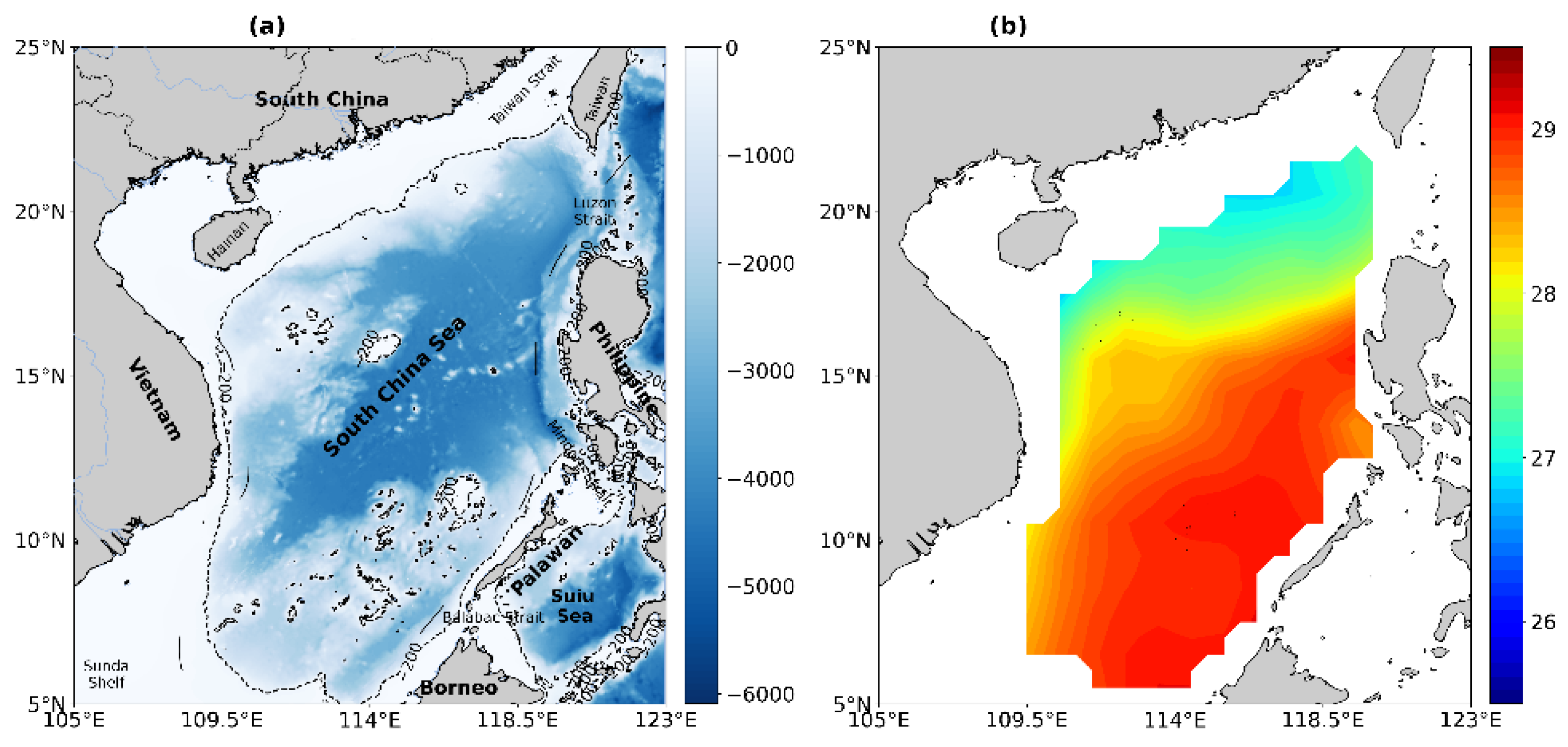

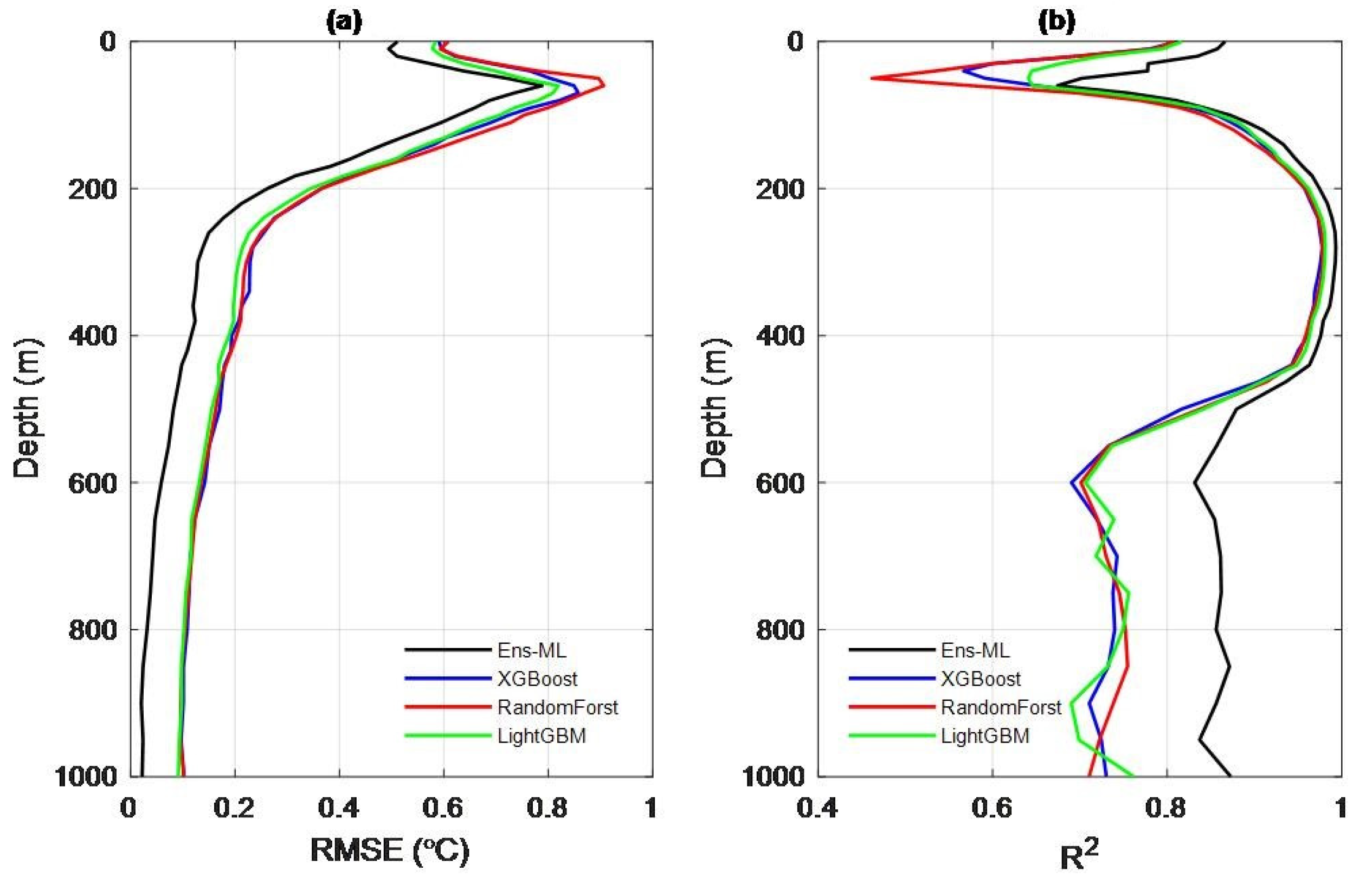

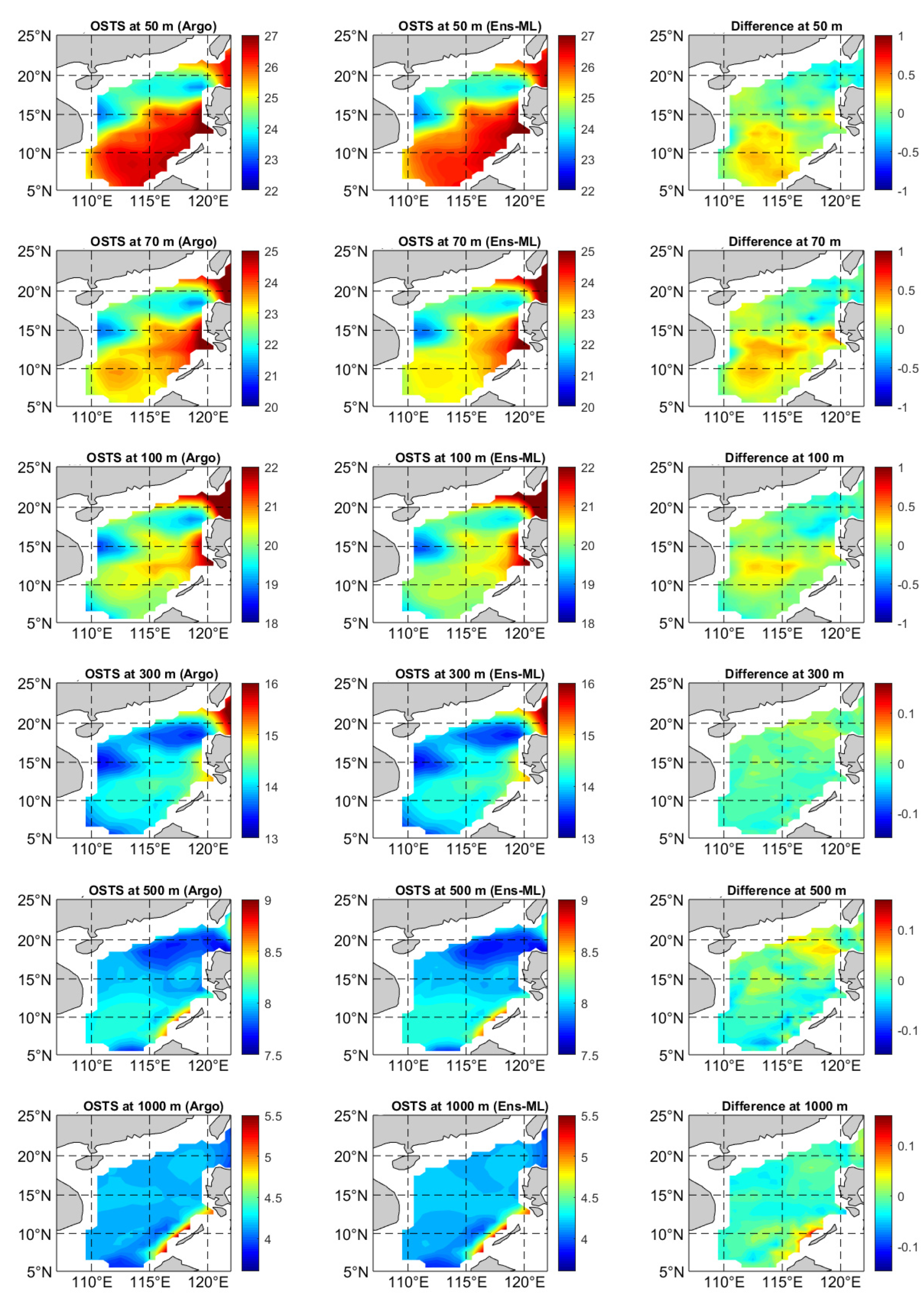
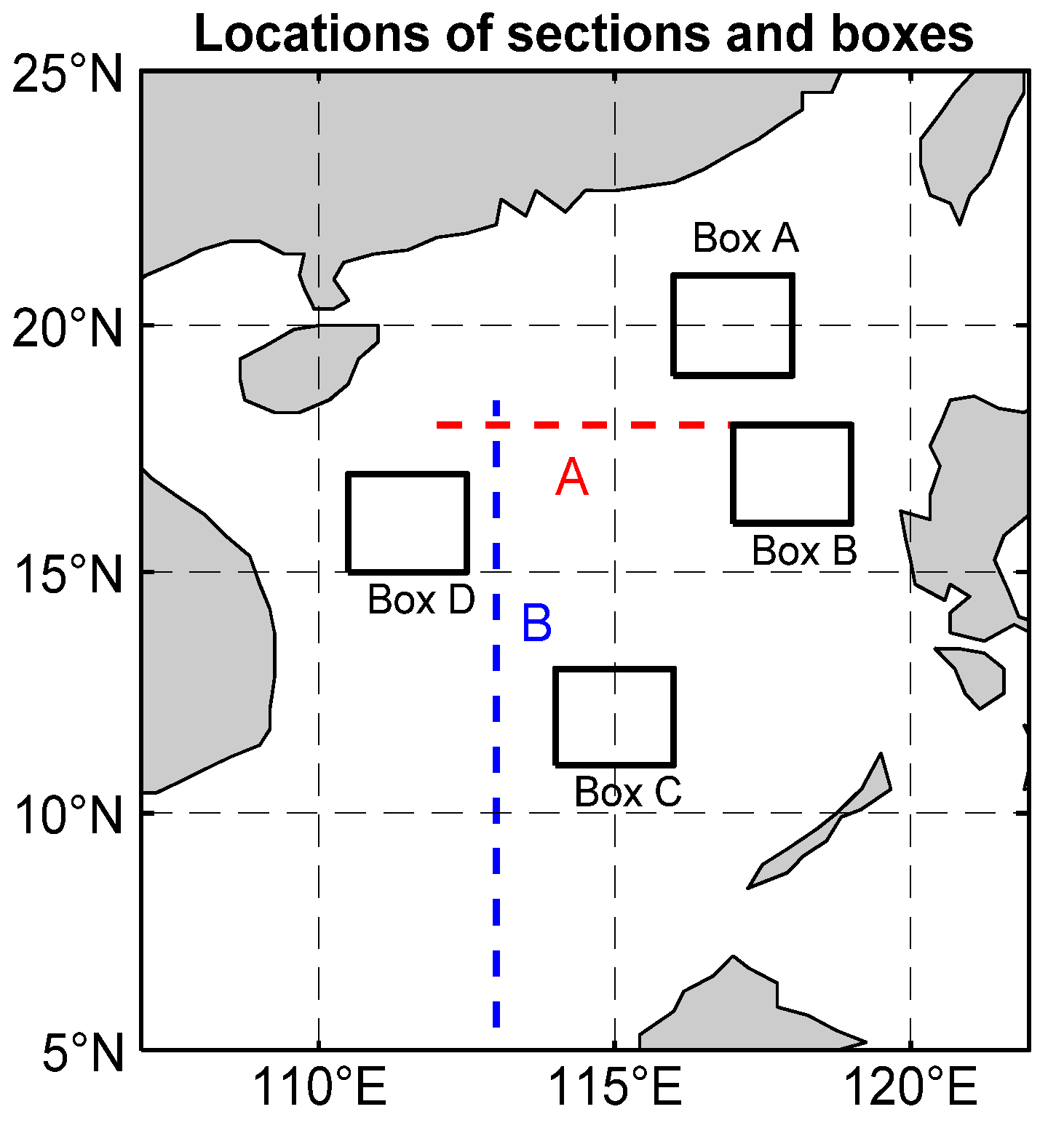
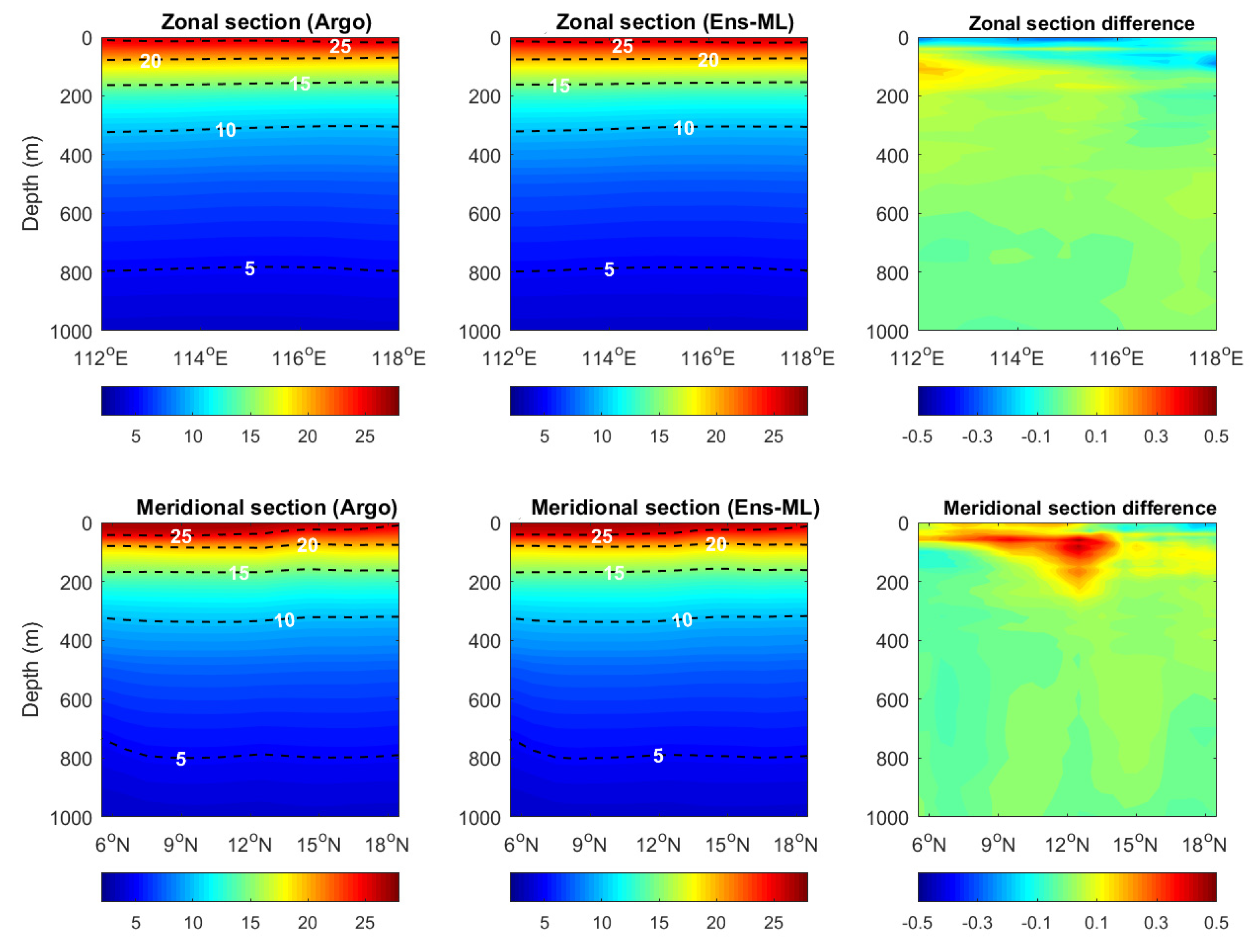
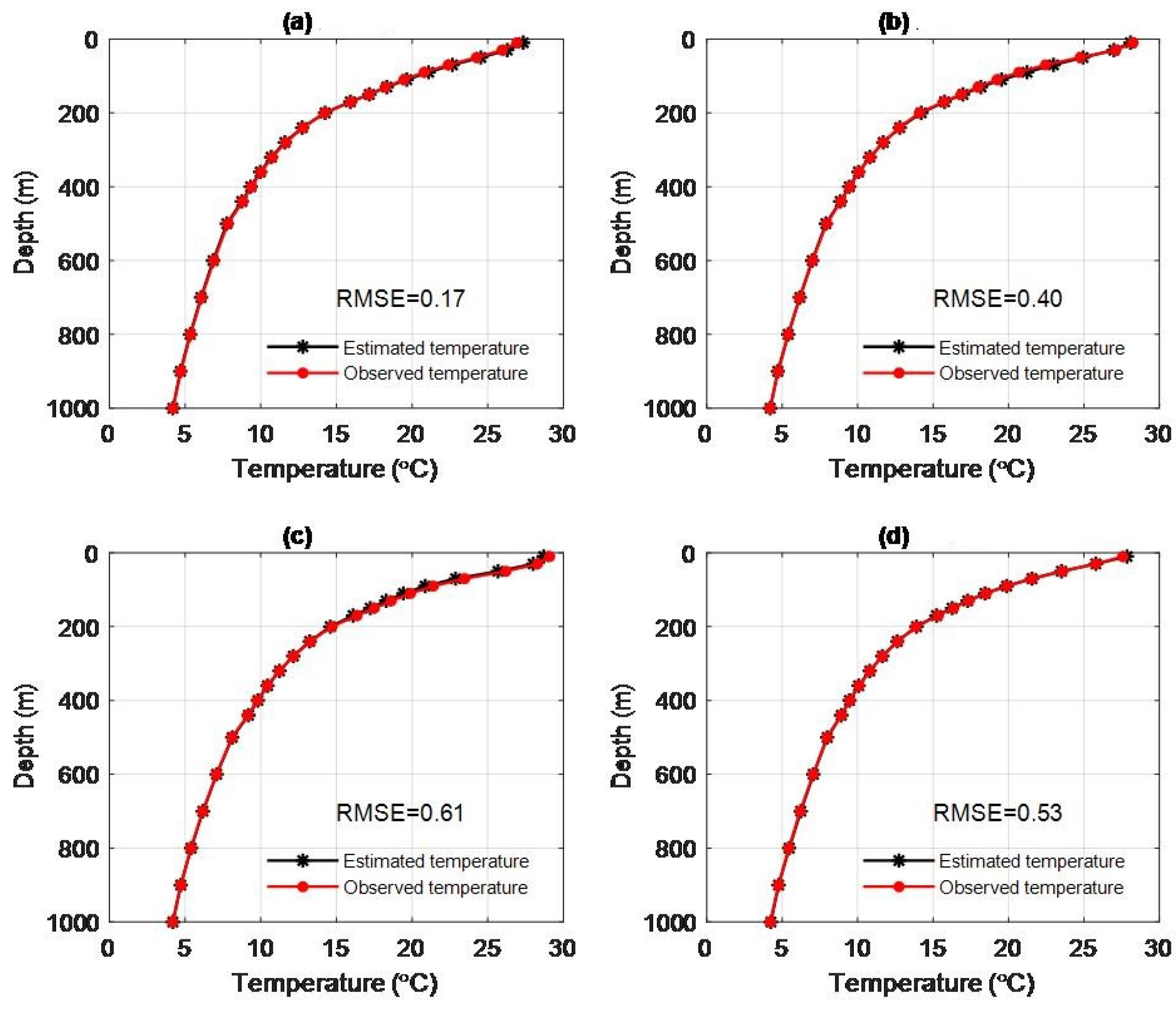
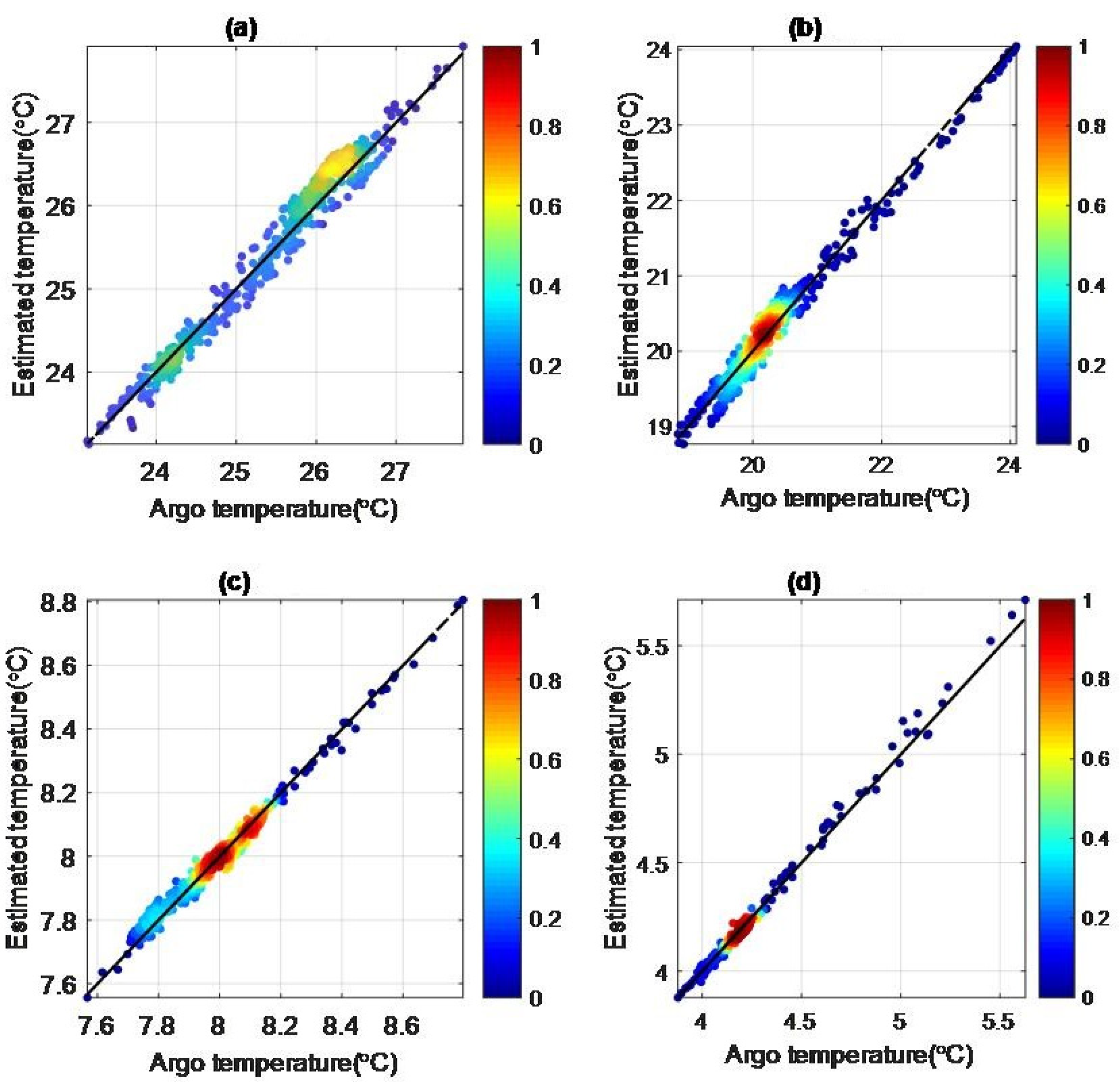
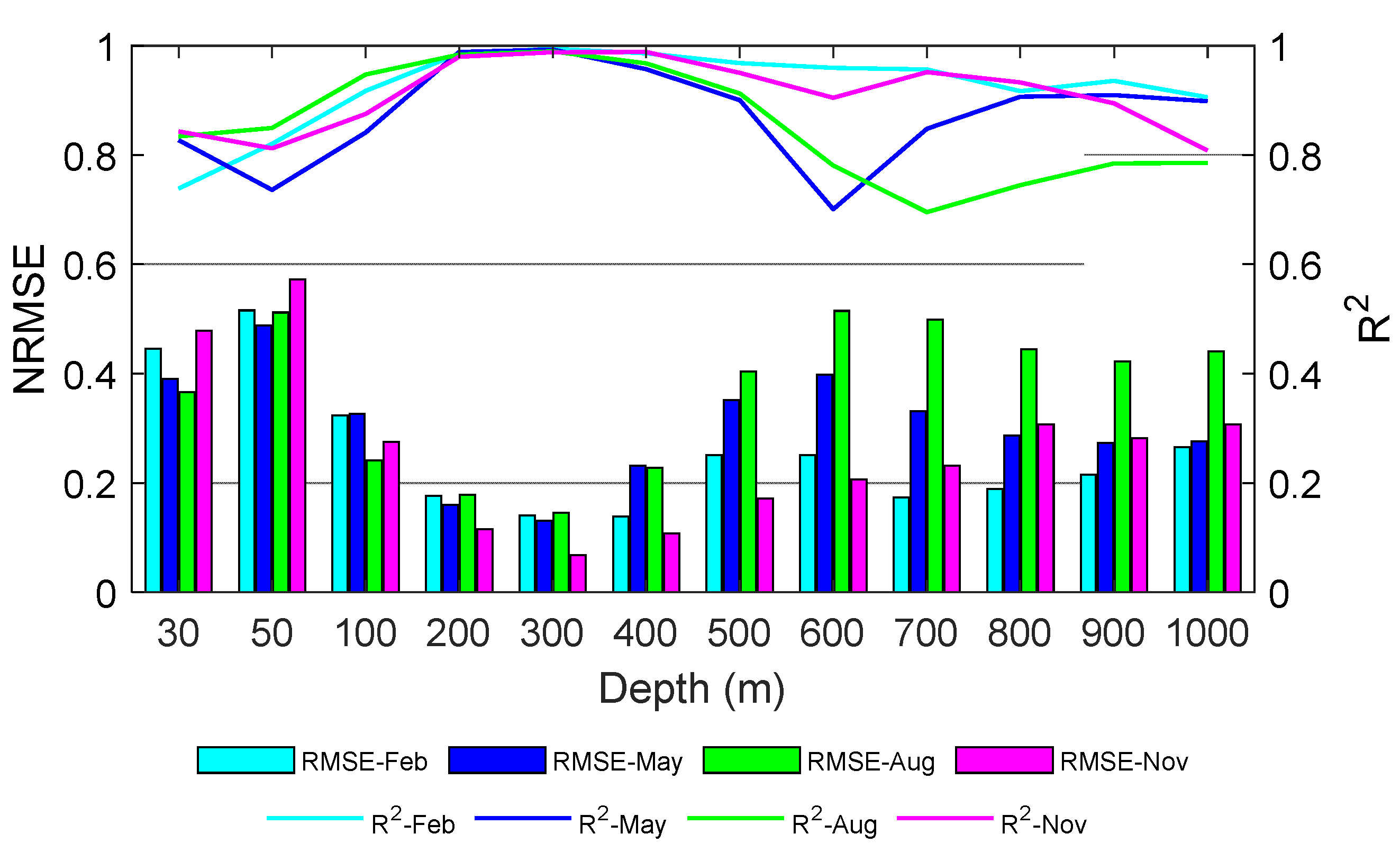
| Index | Contents | |||
|---|---|---|---|---|
| Study Area | South China Sea | 105–122°E, 5–23°N | ||
| Data | SST | 2010–2019 | NOAA (OISST) | input |
| SSS | 2010–2019 | SMOS | ||
| SSH | 2010–2019 | AVISO | ||
| SSW (USSW, VSSW) | 2010–2019 | CCMP | ||
| OSTS | 2010–2019 | RG-Argo | output | |
| 3D temperature field | Temporal and spatial resolution | monthly | 0.5° × 0.5° | |
| Vertical layers | 2.5–1000 m | 44 layers | ||
| Model | Parameters |
|---|---|
| XGBoost | learning_rate = 0.3, n_estimators = 60, max_depth = 6, min_child_weight = 1, colsample_bytree = 1, colsample_bylevel = 1, subsample = 0.8, reg_lambda = 100 |
| RandomForest | n_estimators = 150, max_depth = 21, min_samples_split = 70, min_samples_leaf = 3, max_features = 5, random_state = 10 |
| LightGBM | num_leaves = 55, learning_rate = 0.01, n_estimators = 1000, max_depth = 8, min_child_samples = 20, feature_fraction = 0.8 |
| ANN | number of neural network layers = 4, Residual layers = 2, learning rate = 0.002, batch_size = 1024 |
| OSTS Estimation Models | RMSE | R2 |
|---|---|---|
| Ens-ML | 0.31 | 0.89 |
| XGBoost | 0.39 | 0.83 |
| RandomForest | 0.40 | 0.83 |
| LightGBM | 0.37 | 0.84 |
| Experiments | Training Methods |
|---|---|
| Case 1 (five parameters) | OSTS = Ensemble (SST, SSS, SSH, USSW, VSSW) |
| Case 2 (seven parameters) | OSTS = Ensemble (SST, SSS, SSH, USSW, VSSW, LON, LAT) |
| Depth (m) | RMSE | R2 |
|---|---|---|
| 2.5 | 0.51 | 0.86 |
| 10 | 0.49 | 0.85 |
| 20 | 0.51 | 0.83 |
| 30 | 0.57 | 0.77 |
| 50 | 0.72 | 0.72 |
| 70 | 0.73 | 0.75 |
| 100 | 0.62 | 0.87 |
| 150 | 0.45 | 0.94 |
| 200 | 0.26 | 0.97 |
| 300 | 0.12 | 0.99 |
| 400 | 0.11 | 0.97 |
| 500 | 0.08 | 0.87 |
| 600 | 0.05 | 0.83 |
| 700 | 0.04 | 0.86 |
| 800 | 0.03 | 0.85 |
| 900 | 0.02 | 0.85 |
| 1000 | 0.02 | 0.87 |
Publisher’s Note: MDPI stays neutral with regard to jurisdictional claims in published maps and institutional affiliations. |
© 2022 by the authors. Licensee MDPI, Basel, Switzerland. This article is an open access article distributed under the terms and conditions of the Creative Commons Attribution (CC BY) license (https://creativecommons.org/licenses/by/4.0/).
Share and Cite
Qi, J.; Liu, C.; Chi, J.; Li, D.; Gao, L.; Yin, B. An Ensemble-Based Machine Learning Model for Estimation of Subsurface Thermal Structure in the South China Sea. Remote Sens. 2022, 14, 3207. https://doi.org/10.3390/rs14133207
Qi J, Liu C, Chi J, Li D, Gao L, Yin B. An Ensemble-Based Machine Learning Model for Estimation of Subsurface Thermal Structure in the South China Sea. Remote Sensing. 2022; 14(13):3207. https://doi.org/10.3390/rs14133207
Chicago/Turabian StyleQi, Jifeng, Chuanyu Liu, Jianwei Chi, Delei Li, Le Gao, and Baoshu Yin. 2022. "An Ensemble-Based Machine Learning Model for Estimation of Subsurface Thermal Structure in the South China Sea" Remote Sensing 14, no. 13: 3207. https://doi.org/10.3390/rs14133207
APA StyleQi, J., Liu, C., Chi, J., Li, D., Gao, L., & Yin, B. (2022). An Ensemble-Based Machine Learning Model for Estimation of Subsurface Thermal Structure in the South China Sea. Remote Sensing, 14(13), 3207. https://doi.org/10.3390/rs14133207









